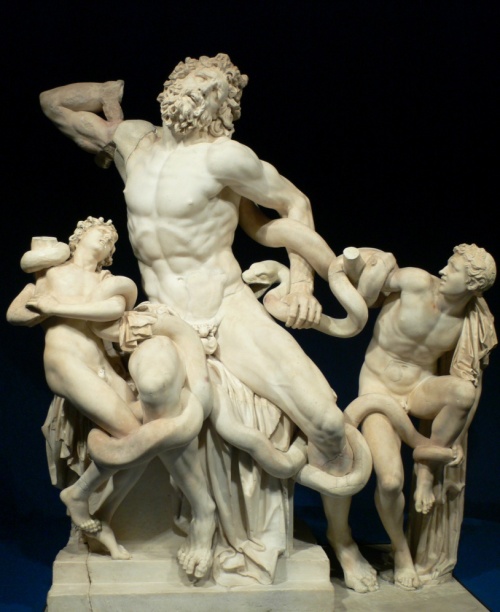
Courtesy of Meredith, some nice reflections an art-historical glosses on Laocoon:
The Laocoön statue is extremely significant in the discipline of art history for both formal and theoretical reasons… at the risk of oversimplifying, here are the highlights that I believe are pertinent for this class:
In Greek mythology (primarily Virgil, though the tale appears in Sophocles too, I believe), Laocoön was the priest who warned the Trojans not to accept the Trojan horse as a gift. He suspected foul play and speared the side of the horse to demonstrate that it was hollow. Before he could convince the Trojans, however, Poseidon (alternately Athena in some accounts) intervened, sending serpents to strangle Laocoön and his sons to their deaths. Art historically, the statue was mentioned in antiquity as well: Pliny the elder talks about the statue as the ideal work of art.
The Laocoön was rediscovered in January of 1506 in a farmer’s field on the Esquiline Hill in Rome near Santa Maria Maggiore. This statue is a Roman marble copy (dating somewhere between 120 and 30 B.C.) of a Greek bronze original from an earlier date.
Formally, the Laocoön greatly influenced many artists from the 16th century onward. Pope Julius II brought in Michelangelo to see it directly after it was found. Michelangelo wrote ecstatically about its impression on him and his subsequent work (the contorting slaves from Julius II’s tomb that he was designing are perhaps the clearest reflection of this). The type of expression found in the musculature found its prime audience perfectly timed with its discovery in the high Renaissance. Innumerable other artists in the following centuries quote the Laocoön both directly and indirectly (Titian, Hubert Robert, El Greco, Blake, etc.). When the statue was found, all three figures were missing their right arms. The Vatican held a contest to see who could create the best “restoration” (read: reconstruction) of the grouping. Michelangelo entered, but was not chosen, though his careful study of the musculature in the arm was actually much more accurate than the chosen reconstruction by Sansovino. This might be due at least in part to the competition between Michelangelo and the contest’s judge, Raphael. Sansovino’s outstretched arm was then fashioned and attached until the 20th century when the original arm (or at least so most scholars agree) was found and reattached. The Sansovino reconstruction is pictured in Blake’s print.
Within the aesthetic/theoretical dialogues of art history, the Laocoön became a touchstone of sorts. One of the seminal figures of “modern” art history, Johann Joachim Winckelmann briefly discussed the Laocoön in his Gedanken uber die Nachahmung der Grieschiechen Werke in der malerey und Bilderkunst, which formed the dominant Enlightenment theories of classical art history. Winckelmann asserted that Laocoön’s gentle expression of pain was emblematic of Greek Stoicism, with its “noble simplicity and quiet grandeur.” Winkelmann wrote that the paradox of admiring the beauty of the statue while also seeing a scene of death and failure supported the idea that it was “a work to be preferred to all the arts of painting and sculpture have produced.”
Gotthold Ephraim Lessing’s Laokoön (1766) was the first counter argument to Winckelmann’s Enlightenment art history. Lessing insisted rather that the expression was due to the moment that the sculptor had chosen to represent. The larger issue for Lessing was that art and poetry were subject to different rules, not the same Ut pictura poesis argument as Winckelmann had asserted. Lessing used the sculpture as a case study in defining the difference between visual arts and literature: literature was limited by time and conventional signs (letters and words) which in themselves meant nothing. In the visual arts, on the other hand, the dimension of time hardly existed, and the means of representation were similar to the things that they represented. Lessing’s work labors to prove that poetry and painting are not interdependent (though they do have similarities). Painting can depict certain qualities that poetry cannot and vice versa. Though little of this notion is original to Lessing, he made it popular and is now remembered primarily for this. After doing some digging, I learned that our friend Henry Fuseli mentioned Lessing’s work in his lectures, which would of course be relevant to Blake, who sketched the Laocoon in Fuseli’s class. Lessing foreshadows modern semiotics when he argues that the sign a specific medium can represent is limited to its mode. For Lessing, Laocoön cannot cry out because sculpture’s mode is the static marble: poetry or drama is the only one that can directly represent Laocoön’s pain.

